Management and Leadership Strategies: Marks & Spencer Report Analysis
VerifiedAdded on 2020/07/22
|14
|4278
|38
Report
AI Summary
This report provides a comprehensive analysis of leadership and operational management within Marks & Spencer (M&S), a major retail firm. It begins by defining the roles and characteristics of effective leaders and managers, emphasizing traits like transparency, vision, innovation, and ethics. The report then explores various management theories, including scientific, bureaucratic, administrative, and contingency theories, evaluating their strengths and weaknesses. Furthermore, it examines the roles of leaders and managers in different organizational situations, such as employee involvement in decision-making, management by objectives, employee motivation, technological advancements, and market competition. The report delves into leadership models like situational leadership, system leadership, contingency theory, and behavioral theory, assessing their advantages and disadvantages. Finally, it addresses key approaches to operational management, including Total Quality Management (TQM), and the roles leaders and managers play in implementing these approaches to achieve business objectives. The report offers insights into how M&S can optimize its operations and achieve its business goals through effective leadership and management strategies.

MANAGEMENT AND
OPERATION
OPERATION
Paraphrase This Document
Need a fresh take? Get an instant paraphrase of this document with our AI Paraphraser
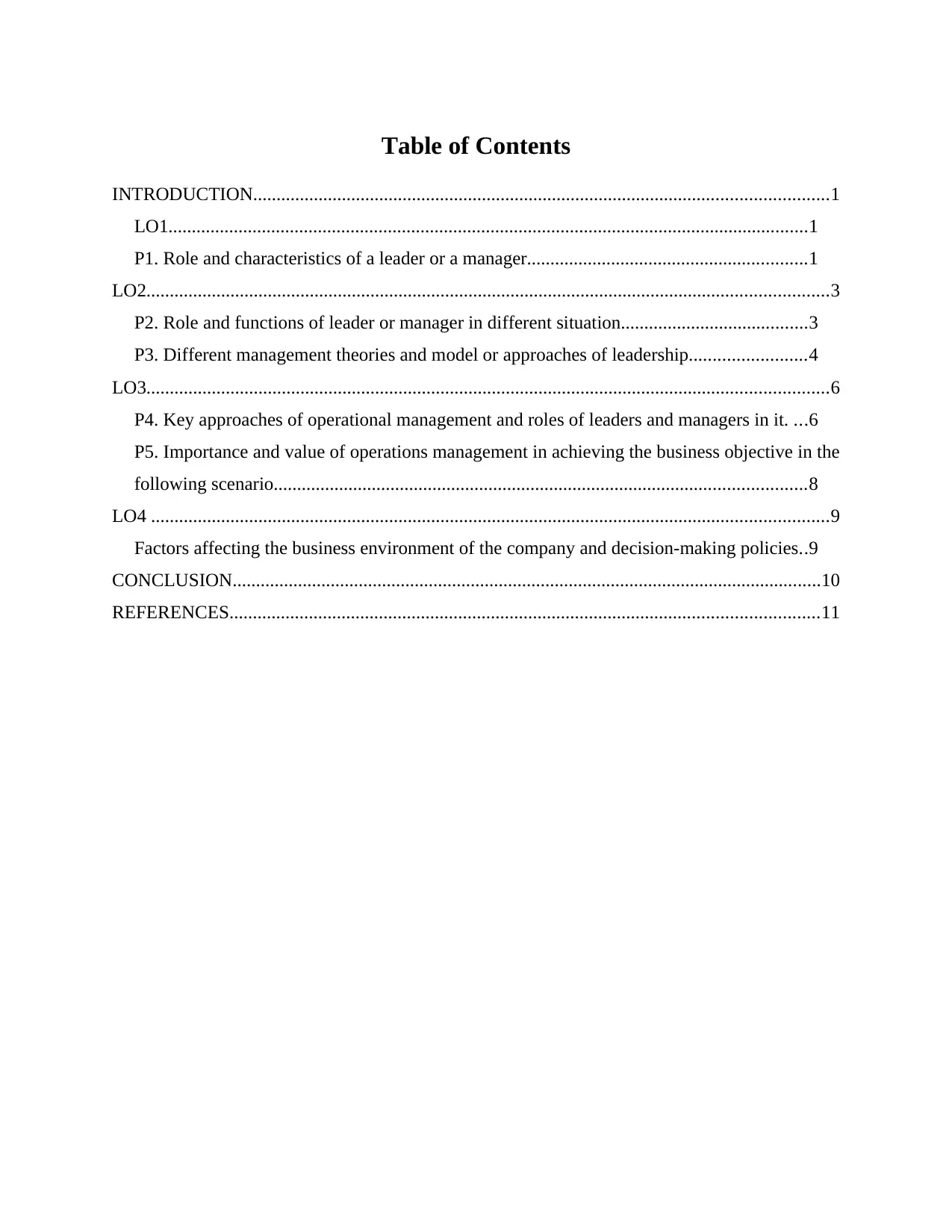
Table of Contents
INTRODUCTION...........................................................................................................................1
LO1.........................................................................................................................................1
P1. Role and characteristics of a leader or a manager............................................................1
LO2..................................................................................................................................................3
P2. Role and functions of leader or manager in different situation........................................3
P3. Different management theories and model or approaches of leadership.........................4
LO3..................................................................................................................................................6
P4. Key approaches of operational management and roles of leaders and managers in it. ...6
P5. Importance and value of operations management in achieving the business objective in the
following scenario..................................................................................................................8
LO4 .................................................................................................................................................9
Factors affecting the business environment of the company and decision-making policies..9
CONCLUSION..............................................................................................................................10
REFERENCES..............................................................................................................................11
INTRODUCTION...........................................................................................................................1
LO1.........................................................................................................................................1
P1. Role and characteristics of a leader or a manager............................................................1
LO2..................................................................................................................................................3
P2. Role and functions of leader or manager in different situation........................................3
P3. Different management theories and model or approaches of leadership.........................4
LO3..................................................................................................................................................6
P4. Key approaches of operational management and roles of leaders and managers in it. ...6
P5. Importance and value of operations management in achieving the business objective in the
following scenario..................................................................................................................8
LO4 .................................................................................................................................................9
Factors affecting the business environment of the company and decision-making policies..9
CONCLUSION..............................................................................................................................10
REFERENCES..............................................................................................................................11
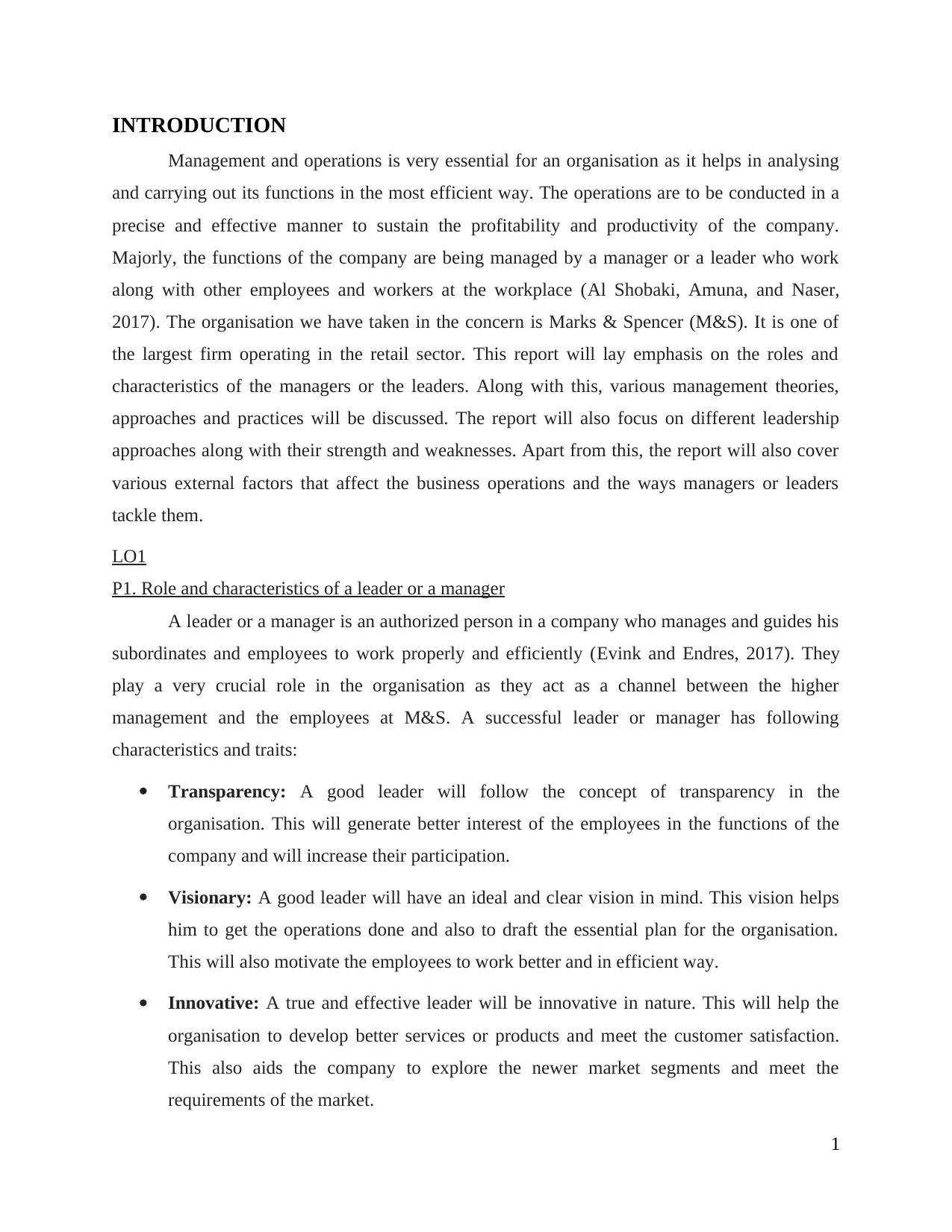
INTRODUCTION
Management and operations is very essential for an organisation as it helps in analysing
and carrying out its functions in the most efficient way. The operations are to be conducted in a
precise and effective manner to sustain the profitability and productivity of the company.
Majorly, the functions of the company are being managed by a manager or a leader who work
along with other employees and workers at the workplace (Al Shobaki, Amuna, and Naser,
2017). The organisation we have taken in the concern is Marks & Spencer (M&S). It is one of
the largest firm operating in the retail sector. This report will lay emphasis on the roles and
characteristics of the managers or the leaders. Along with this, various management theories,
approaches and practices will be discussed. The report will also focus on different leadership
approaches along with their strength and weaknesses. Apart from this, the report will also cover
various external factors that affect the business operations and the ways managers or leaders
tackle them.
LO1
P1. Role and characteristics of a leader or a manager
A leader or a manager is an authorized person in a company who manages and guides his
subordinates and employees to work properly and efficiently (Evink and Endres, 2017). They
play a very crucial role in the organisation as they act as a channel between the higher
management and the employees at M&S. A successful leader or manager has following
characteristics and traits:
Transparency: A good leader will follow the concept of transparency in the
organisation. This will generate better interest of the employees in the functions of the
company and will increase their participation.
Visionary: A good leader will have an ideal and clear vision in mind. This vision helps
him to get the operations done and also to draft the essential plan for the organisation.
This will also motivate the employees to work better and in efficient way.
Innovative: A true and effective leader will be innovative in nature. This will help the
organisation to develop better services or products and meet the customer satisfaction.
This also aids the company to explore the newer market segments and meet the
requirements of the market.
1
Management and operations is very essential for an organisation as it helps in analysing
and carrying out its functions in the most efficient way. The operations are to be conducted in a
precise and effective manner to sustain the profitability and productivity of the company.
Majorly, the functions of the company are being managed by a manager or a leader who work
along with other employees and workers at the workplace (Al Shobaki, Amuna, and Naser,
2017). The organisation we have taken in the concern is Marks & Spencer (M&S). It is one of
the largest firm operating in the retail sector. This report will lay emphasis on the roles and
characteristics of the managers or the leaders. Along with this, various management theories,
approaches and practices will be discussed. The report will also focus on different leadership
approaches along with their strength and weaknesses. Apart from this, the report will also cover
various external factors that affect the business operations and the ways managers or leaders
tackle them.
LO1
P1. Role and characteristics of a leader or a manager
A leader or a manager is an authorized person in a company who manages and guides his
subordinates and employees to work properly and efficiently (Evink and Endres, 2017). They
play a very crucial role in the organisation as they act as a channel between the higher
management and the employees at M&S. A successful leader or manager has following
characteristics and traits:
Transparency: A good leader will follow the concept of transparency in the
organisation. This will generate better interest of the employees in the functions of the
company and will increase their participation.
Visionary: A good leader will have an ideal and clear vision in mind. This vision helps
him to get the operations done and also to draft the essential plan for the organisation.
This will also motivate the employees to work better and in efficient way.
Innovative: A true and effective leader will be innovative in nature. This will help the
organisation to develop better services or products and meet the customer satisfaction.
This also aids the company to explore the newer market segments and meet the
requirements of the market.
1
⊘ This is a preview!⊘
Do you want full access?
Subscribe today to unlock all pages.

Trusted by 1+ million students worldwide
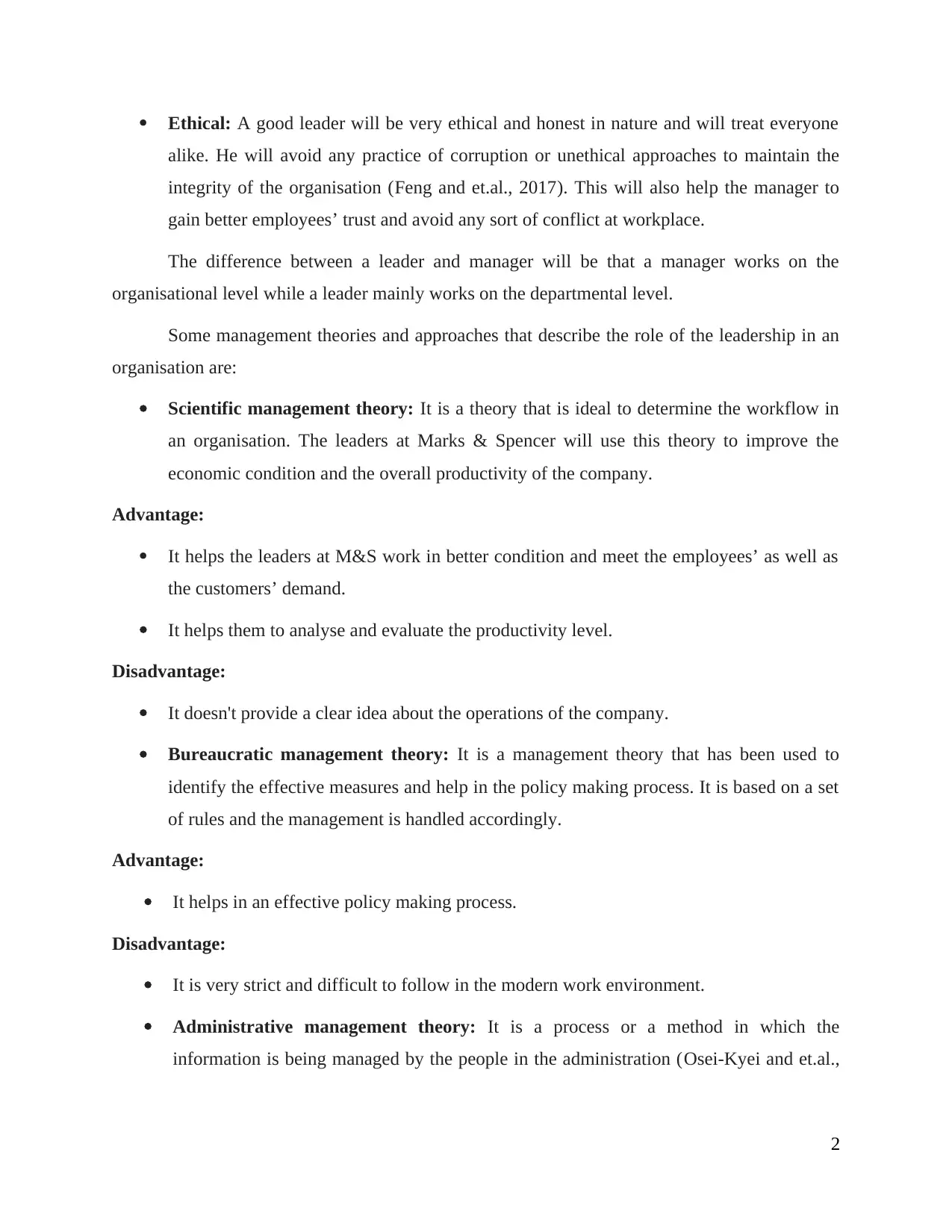
Ethical: A good leader will be very ethical and honest in nature and will treat everyone
alike. He will avoid any practice of corruption or unethical approaches to maintain the
integrity of the organisation (Feng and et.al., 2017). This will also help the manager to
gain better employees’ trust and avoid any sort of conflict at workplace.
The difference between a leader and manager will be that a manager works on the
organisational level while a leader mainly works on the departmental level.
Some management theories and approaches that describe the role of the leadership in an
organisation are:
Scientific management theory: It is a theory that is ideal to determine the workflow in
an organisation. The leaders at Marks & Spencer will use this theory to improve the
economic condition and the overall productivity of the company.
Advantage:
It helps the leaders at M&S work in better condition and meet the employees’ as well as
the customers’ demand.
It helps them to analyse and evaluate the productivity level.
Disadvantage:
It doesn't provide a clear idea about the operations of the company.
Bureaucratic management theory: It is a management theory that has been used to
identify the effective measures and help in the policy making process. It is based on a set
of rules and the management is handled accordingly.
Advantage:
It helps in an effective policy making process.
Disadvantage:
It is very strict and difficult to follow in the modern work environment.
Administrative management theory: It is a process or a method in which the
information is being managed by the people in the administration (Osei-Kyei and et.al.,
2
alike. He will avoid any practice of corruption or unethical approaches to maintain the
integrity of the organisation (Feng and et.al., 2017). This will also help the manager to
gain better employees’ trust and avoid any sort of conflict at workplace.
The difference between a leader and manager will be that a manager works on the
organisational level while a leader mainly works on the departmental level.
Some management theories and approaches that describe the role of the leadership in an
organisation are:
Scientific management theory: It is a theory that is ideal to determine the workflow in
an organisation. The leaders at Marks & Spencer will use this theory to improve the
economic condition and the overall productivity of the company.
Advantage:
It helps the leaders at M&S work in better condition and meet the employees’ as well as
the customers’ demand.
It helps them to analyse and evaluate the productivity level.
Disadvantage:
It doesn't provide a clear idea about the operations of the company.
Bureaucratic management theory: It is a management theory that has been used to
identify the effective measures and help in the policy making process. It is based on a set
of rules and the management is handled accordingly.
Advantage:
It helps in an effective policy making process.
Disadvantage:
It is very strict and difficult to follow in the modern work environment.
Administrative management theory: It is a process or a method in which the
information is being managed by the people in the administration (Osei-Kyei and et.al.,
2
Paraphrase This Document
Need a fresh take? Get an instant paraphrase of this document with our AI Paraphraser
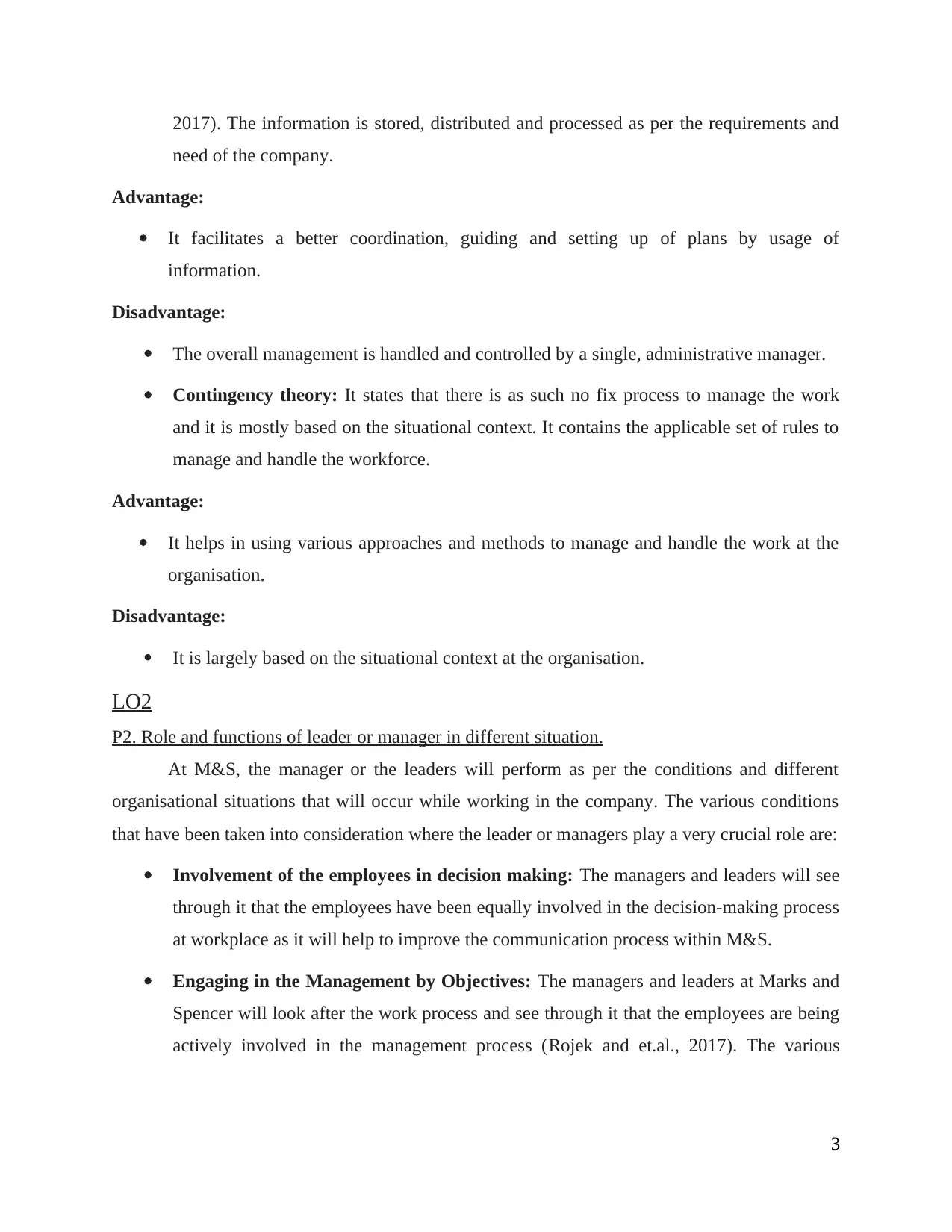
2017). The information is stored, distributed and processed as per the requirements and
need of the company.
Advantage:
It facilitates a better coordination, guiding and setting up of plans by usage of
information.
Disadvantage:
The overall management is handled and controlled by a single, administrative manager.
Contingency theory: It states that there is as such no fix process to manage the work
and it is mostly based on the situational context. It contains the applicable set of rules to
manage and handle the workforce.
Advantage:
It helps in using various approaches and methods to manage and handle the work at the
organisation.
Disadvantage:
It is largely based on the situational context at the organisation.
LO2
P2. Role and functions of leader or manager in different situation.
At M&S, the manager or the leaders will perform as per the conditions and different
organisational situations that will occur while working in the company. The various conditions
that have been taken into consideration where the leader or managers play a very crucial role are:
Involvement of the employees in decision making: The managers and leaders will see
through it that the employees have been equally involved in the decision-making process
at workplace as it will help to improve the communication process within M&S.
Engaging in the Management by Objectives: The managers and leaders at Marks and
Spencer will look after the work process and see through it that the employees are being
actively involved in the management process (Rojek and et.al., 2017). The various
3
need of the company.
Advantage:
It facilitates a better coordination, guiding and setting up of plans by usage of
information.
Disadvantage:
The overall management is handled and controlled by a single, administrative manager.
Contingency theory: It states that there is as such no fix process to manage the work
and it is mostly based on the situational context. It contains the applicable set of rules to
manage and handle the workforce.
Advantage:
It helps in using various approaches and methods to manage and handle the work at the
organisation.
Disadvantage:
It is largely based on the situational context at the organisation.
LO2
P2. Role and functions of leader or manager in different situation.
At M&S, the manager or the leaders will perform as per the conditions and different
organisational situations that will occur while working in the company. The various conditions
that have been taken into consideration where the leader or managers play a very crucial role are:
Involvement of the employees in decision making: The managers and leaders will see
through it that the employees have been equally involved in the decision-making process
at workplace as it will help to improve the communication process within M&S.
Engaging in the Management by Objectives: The managers and leaders at Marks and
Spencer will look after the work process and see through it that the employees are being
actively involved in the management process (Rojek and et.al., 2017). The various
3
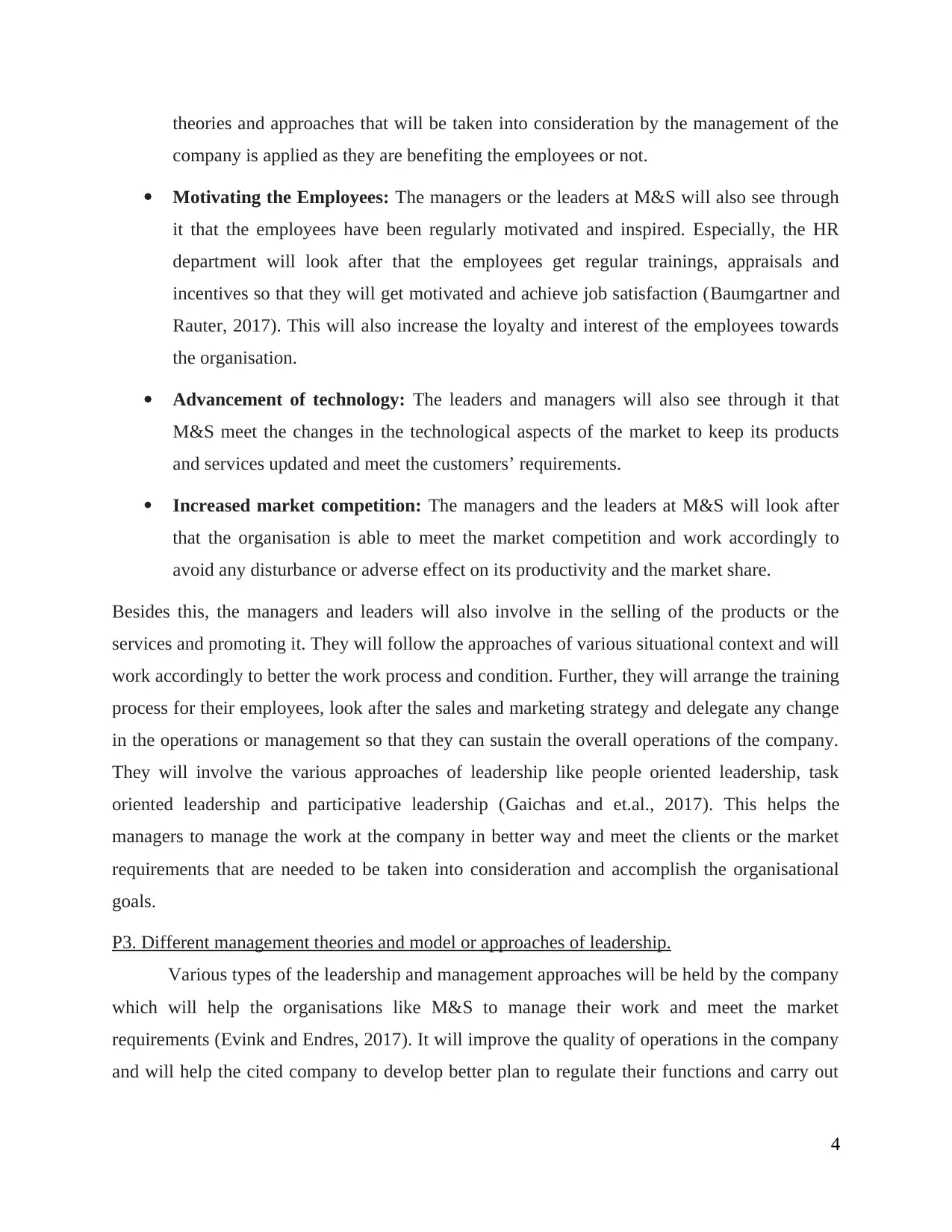
theories and approaches that will be taken into consideration by the management of the
company is applied as they are benefiting the employees or not.
Motivating the Employees: The managers or the leaders at M&S will also see through
it that the employees have been regularly motivated and inspired. Especially, the HR
department will look after that the employees get regular trainings, appraisals and
incentives so that they will get motivated and achieve job satisfaction (Baumgartner and
Rauter, 2017). This will also increase the loyalty and interest of the employees towards
the organisation.
Advancement of technology: The leaders and managers will also see through it that
M&S meet the changes in the technological aspects of the market to keep its products
and services updated and meet the customers’ requirements.
Increased market competition: The managers and the leaders at M&S will look after
that the organisation is able to meet the market competition and work accordingly to
avoid any disturbance or adverse effect on its productivity and the market share.
Besides this, the managers and leaders will also involve in the selling of the products or the
services and promoting it. They will follow the approaches of various situational context and will
work accordingly to better the work process and condition. Further, they will arrange the training
process for their employees, look after the sales and marketing strategy and delegate any change
in the operations or management so that they can sustain the overall operations of the company.
They will involve the various approaches of leadership like people oriented leadership, task
oriented leadership and participative leadership (Gaichas and et.al., 2017). This helps the
managers to manage the work at the company in better way and meet the clients or the market
requirements that are needed to be taken into consideration and accomplish the organisational
goals.
P3. Different management theories and model or approaches of leadership.
Various types of the leadership and management approaches will be held by the company
which will help the organisations like M&S to manage their work and meet the market
requirements (Evink and Endres, 2017). It will improve the quality of operations in the company
and will help the cited company to develop better plan to regulate their functions and carry out
4
company is applied as they are benefiting the employees or not.
Motivating the Employees: The managers or the leaders at M&S will also see through
it that the employees have been regularly motivated and inspired. Especially, the HR
department will look after that the employees get regular trainings, appraisals and
incentives so that they will get motivated and achieve job satisfaction (Baumgartner and
Rauter, 2017). This will also increase the loyalty and interest of the employees towards
the organisation.
Advancement of technology: The leaders and managers will also see through it that
M&S meet the changes in the technological aspects of the market to keep its products
and services updated and meet the customers’ requirements.
Increased market competition: The managers and the leaders at M&S will look after
that the organisation is able to meet the market competition and work accordingly to
avoid any disturbance or adverse effect on its productivity and the market share.
Besides this, the managers and leaders will also involve in the selling of the products or the
services and promoting it. They will follow the approaches of various situational context and will
work accordingly to better the work process and condition. Further, they will arrange the training
process for their employees, look after the sales and marketing strategy and delegate any change
in the operations or management so that they can sustain the overall operations of the company.
They will involve the various approaches of leadership like people oriented leadership, task
oriented leadership and participative leadership (Gaichas and et.al., 2017). This helps the
managers to manage the work at the company in better way and meet the clients or the market
requirements that are needed to be taken into consideration and accomplish the organisational
goals.
P3. Different management theories and model or approaches of leadership.
Various types of the leadership and management approaches will be held by the company
which will help the organisations like M&S to manage their work and meet the market
requirements (Evink and Endres, 2017). It will improve the quality of operations in the company
and will help the cited company to develop better plan to regulate their functions and carry out
4
⊘ This is a preview!⊘
Do you want full access?
Subscribe today to unlock all pages.

Trusted by 1+ million students worldwide
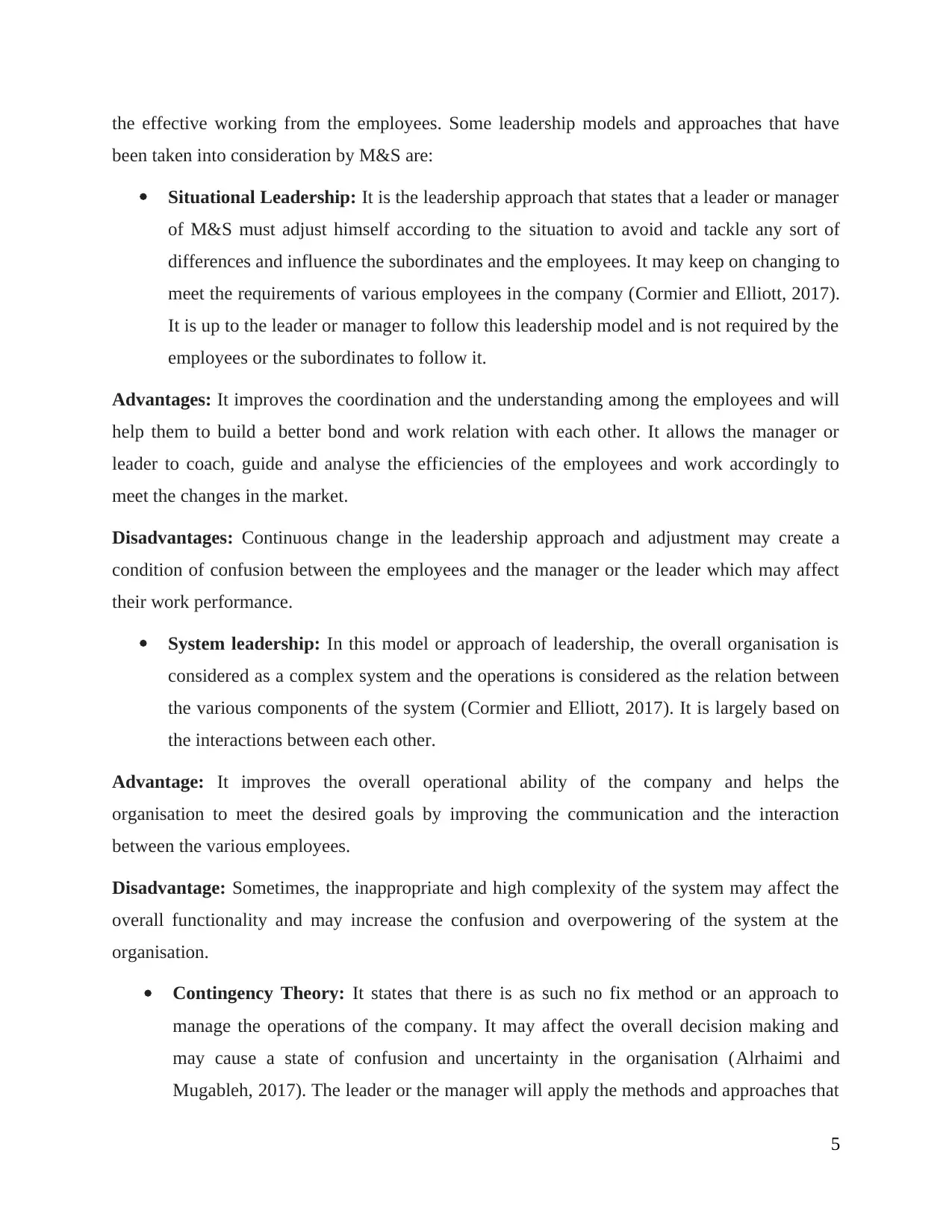
the effective working from the employees. Some leadership models and approaches that have
been taken into consideration by M&S are:
Situational Leadership: It is the leadership approach that states that a leader or manager
of M&S must adjust himself according to the situation to avoid and tackle any sort of
differences and influence the subordinates and the employees. It may keep on changing to
meet the requirements of various employees in the company (Cormier and Elliott, 2017).
It is up to the leader or manager to follow this leadership model and is not required by the
employees or the subordinates to follow it.
Advantages: It improves the coordination and the understanding among the employees and will
help them to build a better bond and work relation with each other. It allows the manager or
leader to coach, guide and analyse the efficiencies of the employees and work accordingly to
meet the changes in the market.
Disadvantages: Continuous change in the leadership approach and adjustment may create a
condition of confusion between the employees and the manager or the leader which may affect
their work performance.
System leadership: In this model or approach of leadership, the overall organisation is
considered as a complex system and the operations is considered as the relation between
the various components of the system (Cormier and Elliott, 2017). It is largely based on
the interactions between each other.
Advantage: It improves the overall operational ability of the company and helps the
organisation to meet the desired goals by improving the communication and the interaction
between the various employees.
Disadvantage: Sometimes, the inappropriate and high complexity of the system may affect the
overall functionality and may increase the confusion and overpowering of the system at the
organisation.
Contingency Theory: It states that there is as such no fix method or an approach to
manage the operations of the company. It may affect the overall decision making and
may cause a state of confusion and uncertainty in the organisation (Alrhaimi and
Mugableh, 2017). The leader or the manager will apply the methods and approaches that
5
been taken into consideration by M&S are:
Situational Leadership: It is the leadership approach that states that a leader or manager
of M&S must adjust himself according to the situation to avoid and tackle any sort of
differences and influence the subordinates and the employees. It may keep on changing to
meet the requirements of various employees in the company (Cormier and Elliott, 2017).
It is up to the leader or manager to follow this leadership model and is not required by the
employees or the subordinates to follow it.
Advantages: It improves the coordination and the understanding among the employees and will
help them to build a better bond and work relation with each other. It allows the manager or
leader to coach, guide and analyse the efficiencies of the employees and work accordingly to
meet the changes in the market.
Disadvantages: Continuous change in the leadership approach and adjustment may create a
condition of confusion between the employees and the manager or the leader which may affect
their work performance.
System leadership: In this model or approach of leadership, the overall organisation is
considered as a complex system and the operations is considered as the relation between
the various components of the system (Cormier and Elliott, 2017). It is largely based on
the interactions between each other.
Advantage: It improves the overall operational ability of the company and helps the
organisation to meet the desired goals by improving the communication and the interaction
between the various employees.
Disadvantage: Sometimes, the inappropriate and high complexity of the system may affect the
overall functionality and may increase the confusion and overpowering of the system at the
organisation.
Contingency Theory: It states that there is as such no fix method or an approach to
manage the operations of the company. It may affect the overall decision making and
may cause a state of confusion and uncertainty in the organisation (Alrhaimi and
Mugableh, 2017). The leader or the manager will apply the methods and approaches that
5
Paraphrase This Document
Need a fresh take? Get an instant paraphrase of this document with our AI Paraphraser
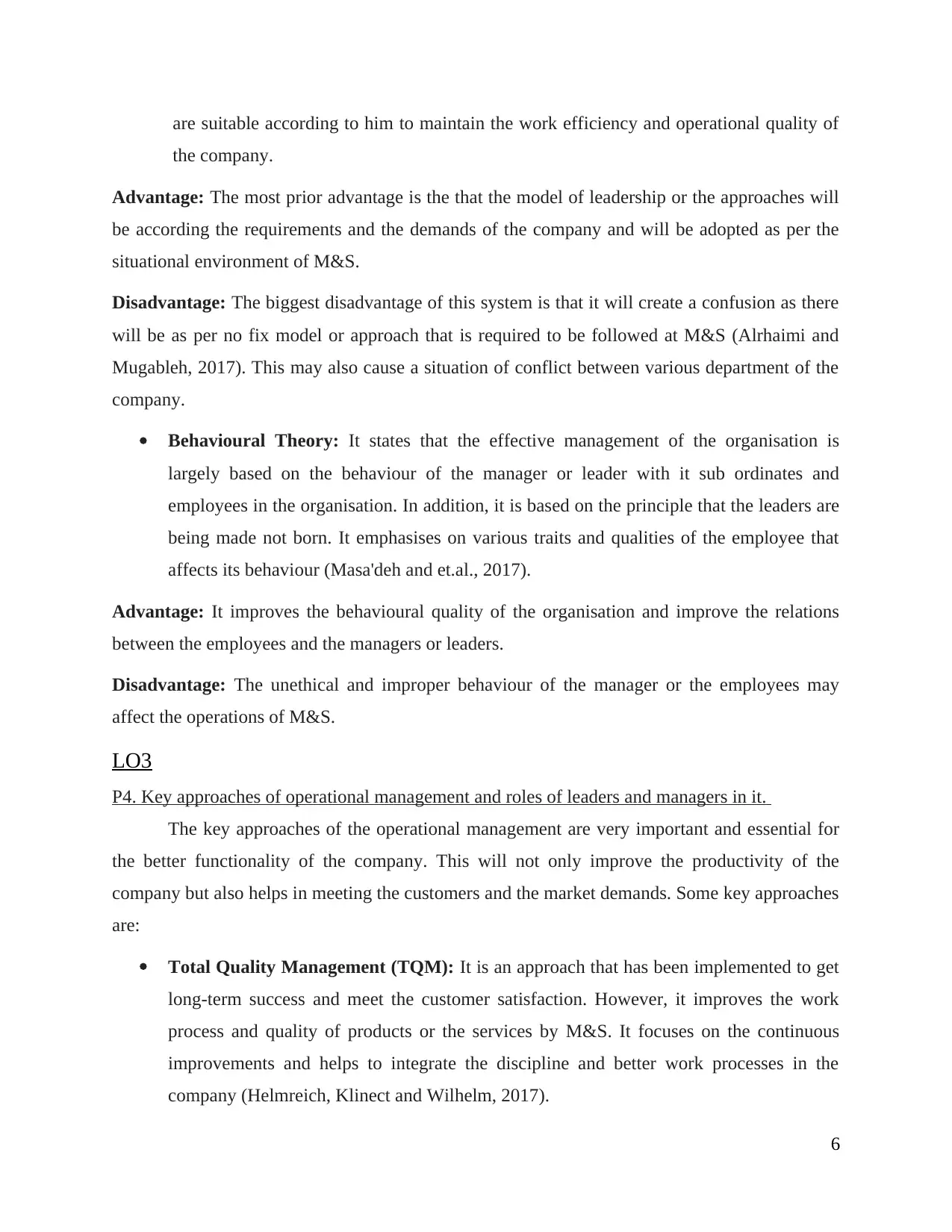
are suitable according to him to maintain the work efficiency and operational quality of
the company.
Advantage: The most prior advantage is the that the model of leadership or the approaches will
be according the requirements and the demands of the company and will be adopted as per the
situational environment of M&S.
Disadvantage: The biggest disadvantage of this system is that it will create a confusion as there
will be as per no fix model or approach that is required to be followed at M&S (Alrhaimi and
Mugableh, 2017). This may also cause a situation of conflict between various department of the
company.
Behavioural Theory: It states that the effective management of the organisation is
largely based on the behaviour of the manager or leader with it sub ordinates and
employees in the organisation. In addition, it is based on the principle that the leaders are
being made not born. It emphasises on various traits and qualities of the employee that
affects its behaviour (Masa'deh and et.al., 2017).
Advantage: It improves the behavioural quality of the organisation and improve the relations
between the employees and the managers or leaders.
Disadvantage: The unethical and improper behaviour of the manager or the employees may
affect the operations of M&S.
LO3
P4. Key approaches of operational management and roles of leaders and managers in it.
The key approaches of the operational management are very important and essential for
the better functionality of the company. This will not only improve the productivity of the
company but also helps in meeting the customers and the market demands. Some key approaches
are:
Total Quality Management (TQM): It is an approach that has been implemented to get
long-term success and meet the customer satisfaction. However, it improves the work
process and quality of products or the services by M&S. It focuses on the continuous
improvements and helps to integrate the discipline and better work processes in the
company (Helmreich, Klinect and Wilhelm, 2017).
6
the company.
Advantage: The most prior advantage is the that the model of leadership or the approaches will
be according the requirements and the demands of the company and will be adopted as per the
situational environment of M&S.
Disadvantage: The biggest disadvantage of this system is that it will create a confusion as there
will be as per no fix model or approach that is required to be followed at M&S (Alrhaimi and
Mugableh, 2017). This may also cause a situation of conflict between various department of the
company.
Behavioural Theory: It states that the effective management of the organisation is
largely based on the behaviour of the manager or leader with it sub ordinates and
employees in the organisation. In addition, it is based on the principle that the leaders are
being made not born. It emphasises on various traits and qualities of the employee that
affects its behaviour (Masa'deh and et.al., 2017).
Advantage: It improves the behavioural quality of the organisation and improve the relations
between the employees and the managers or leaders.
Disadvantage: The unethical and improper behaviour of the manager or the employees may
affect the operations of M&S.
LO3
P4. Key approaches of operational management and roles of leaders and managers in it.
The key approaches of the operational management are very important and essential for
the better functionality of the company. This will not only improve the productivity of the
company but also helps in meeting the customers and the market demands. Some key approaches
are:
Total Quality Management (TQM): It is an approach that has been implemented to get
long-term success and meet the customer satisfaction. However, it improves the work
process and quality of products or the services by M&S. It focuses on the continuous
improvements and helps to integrate the discipline and better work processes in the
company (Helmreich, Klinect and Wilhelm, 2017).
6
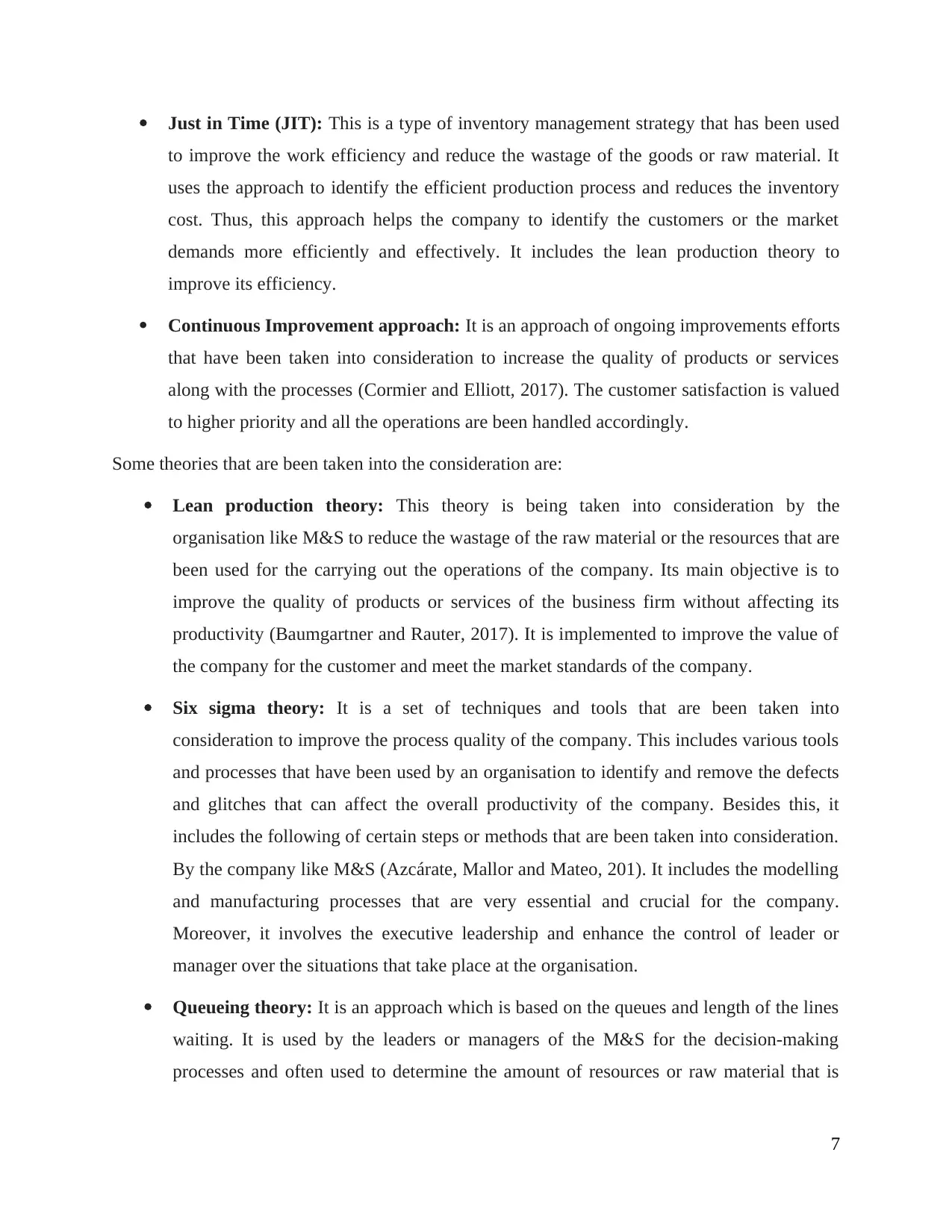
Just in Time (JIT): This is a type of inventory management strategy that has been used
to improve the work efficiency and reduce the wastage of the goods or raw material. It
uses the approach to identify the efficient production process and reduces the inventory
cost. Thus, this approach helps the company to identify the customers or the market
demands more efficiently and effectively. It includes the lean production theory to
improve its efficiency.
Continuous Improvement approach: It is an approach of ongoing improvements efforts
that have been taken into consideration to increase the quality of products or services
along with the processes (Cormier and Elliott, 2017). The customer satisfaction is valued
to higher priority and all the operations are been handled accordingly.
Some theories that are been taken into the consideration are:
Lean production theory: This theory is being taken into consideration by the
organisation like M&S to reduce the wastage of the raw material or the resources that are
been used for the carrying out the operations of the company. Its main objective is to
improve the quality of products or services of the business firm without affecting its
productivity (Baumgartner and Rauter, 2017). It is implemented to improve the value of
the company for the customer and meet the market standards of the company.
Six sigma theory: It is a set of techniques and tools that are been taken into
consideration to improve the process quality of the company. This includes various tools
and processes that have been used by an organisation to identify and remove the defects
and glitches that can affect the overall productivity of the company. Besides this, it
includes the following of certain steps or methods that are been taken into consideration.
By the company like M&S (Azcárate, Mallor and Mateo, 201). It includes the modelling
and manufacturing processes that are very essential and crucial for the company.
Moreover, it involves the executive leadership and enhance the control of leader or
manager over the situations that take place at the organisation.
Queueing theory: It is an approach which is based on the queues and length of the lines
waiting. It is used by the leaders or managers of the M&S for the decision-making
processes and often used to determine the amount of resources or raw material that is
7
to improve the work efficiency and reduce the wastage of the goods or raw material. It
uses the approach to identify the efficient production process and reduces the inventory
cost. Thus, this approach helps the company to identify the customers or the market
demands more efficiently and effectively. It includes the lean production theory to
improve its efficiency.
Continuous Improvement approach: It is an approach of ongoing improvements efforts
that have been taken into consideration to increase the quality of products or services
along with the processes (Cormier and Elliott, 2017). The customer satisfaction is valued
to higher priority and all the operations are been handled accordingly.
Some theories that are been taken into the consideration are:
Lean production theory: This theory is being taken into consideration by the
organisation like M&S to reduce the wastage of the raw material or the resources that are
been used for the carrying out the operations of the company. Its main objective is to
improve the quality of products or services of the business firm without affecting its
productivity (Baumgartner and Rauter, 2017). It is implemented to improve the value of
the company for the customer and meet the market standards of the company.
Six sigma theory: It is a set of techniques and tools that are been taken into
consideration to improve the process quality of the company. This includes various tools
and processes that have been used by an organisation to identify and remove the defects
and glitches that can affect the overall productivity of the company. Besides this, it
includes the following of certain steps or methods that are been taken into consideration.
By the company like M&S (Azcárate, Mallor and Mateo, 201). It includes the modelling
and manufacturing processes that are very essential and crucial for the company.
Moreover, it involves the executive leadership and enhance the control of leader or
manager over the situations that take place at the organisation.
Queueing theory: It is an approach which is based on the queues and length of the lines
waiting. It is used by the leaders or managers of the M&S for the decision-making
processes and often used to determine the amount of resources or raw material that is
7
⊘ This is a preview!⊘
Do you want full access?
Subscribe today to unlock all pages.

Trusted by 1+ million students worldwide

been required by the company to run its operations (Gaichas and et.al., 2017). It is very
important for the project management.
The managers or the leaders at M&S will play a very crucial and essential role as they
will look after the efficient implementation of these processes and take the effective measure to
make it successful.
P5. Importance and value of operations management in achieving the business objective in the
following scenario.
Operational management plays a very crucial role in achieving the business objective of the
organisation. Some scenarios are:
Customer satisfaction: The efficient management of the operations at M&S will help
the company to meet the customer's demand and satisfaction level. The effective
measures that are been taken by the managers or the leaders to improve the work quality
and meet the demands of the market.
Efficiency: The effective implementation of the measures that have been taken into
consideration by the managers and the leaders at Marks and Spencer's will be very
important to improve the operational efficiency of the company (Alrhaimi and Mugableh,
2017). This will increase the productivity and the managers or the leaders will provide
the employees essential training which will help them to work better and enhance the
work quality of M&S.
Reduction of Waste: The approaches like lean management and JIT will help the
managers and the leaders at M&S to utilize the available resources in the most effective
way and reduce the wastage which will help the company to economically sustain its
growth and maintain its operations by improving their quality.
Effective allocation and utilization of resources: The queueing approach will help the
company to apply the better resource allocation and utilization of the resources that are
been available to the company and will improve their productivity.
The above factors play an important role in the operating of the business of M&S as they
will contribute in the growth of the company as in whole and will increase the productivity of the
business firm which will help the company to gain a better customer satisfaction level. With the
8
important for the project management.
The managers or the leaders at M&S will play a very crucial and essential role as they
will look after the efficient implementation of these processes and take the effective measure to
make it successful.
P5. Importance and value of operations management in achieving the business objective in the
following scenario.
Operational management plays a very crucial role in achieving the business objective of the
organisation. Some scenarios are:
Customer satisfaction: The efficient management of the operations at M&S will help
the company to meet the customer's demand and satisfaction level. The effective
measures that are been taken by the managers or the leaders to improve the work quality
and meet the demands of the market.
Efficiency: The effective implementation of the measures that have been taken into
consideration by the managers and the leaders at Marks and Spencer's will be very
important to improve the operational efficiency of the company (Alrhaimi and Mugableh,
2017). This will increase the productivity and the managers or the leaders will provide
the employees essential training which will help them to work better and enhance the
work quality of M&S.
Reduction of Waste: The approaches like lean management and JIT will help the
managers and the leaders at M&S to utilize the available resources in the most effective
way and reduce the wastage which will help the company to economically sustain its
growth and maintain its operations by improving their quality.
Effective allocation and utilization of resources: The queueing approach will help the
company to apply the better resource allocation and utilization of the resources that are
been available to the company and will improve their productivity.
The above factors play an important role in the operating of the business of M&S as they
will contribute in the growth of the company as in whole and will increase the productivity of the
business firm which will help the company to gain a better customer satisfaction level. With the
8
Paraphrase This Document
Need a fresh take? Get an instant paraphrase of this document with our AI Paraphraser
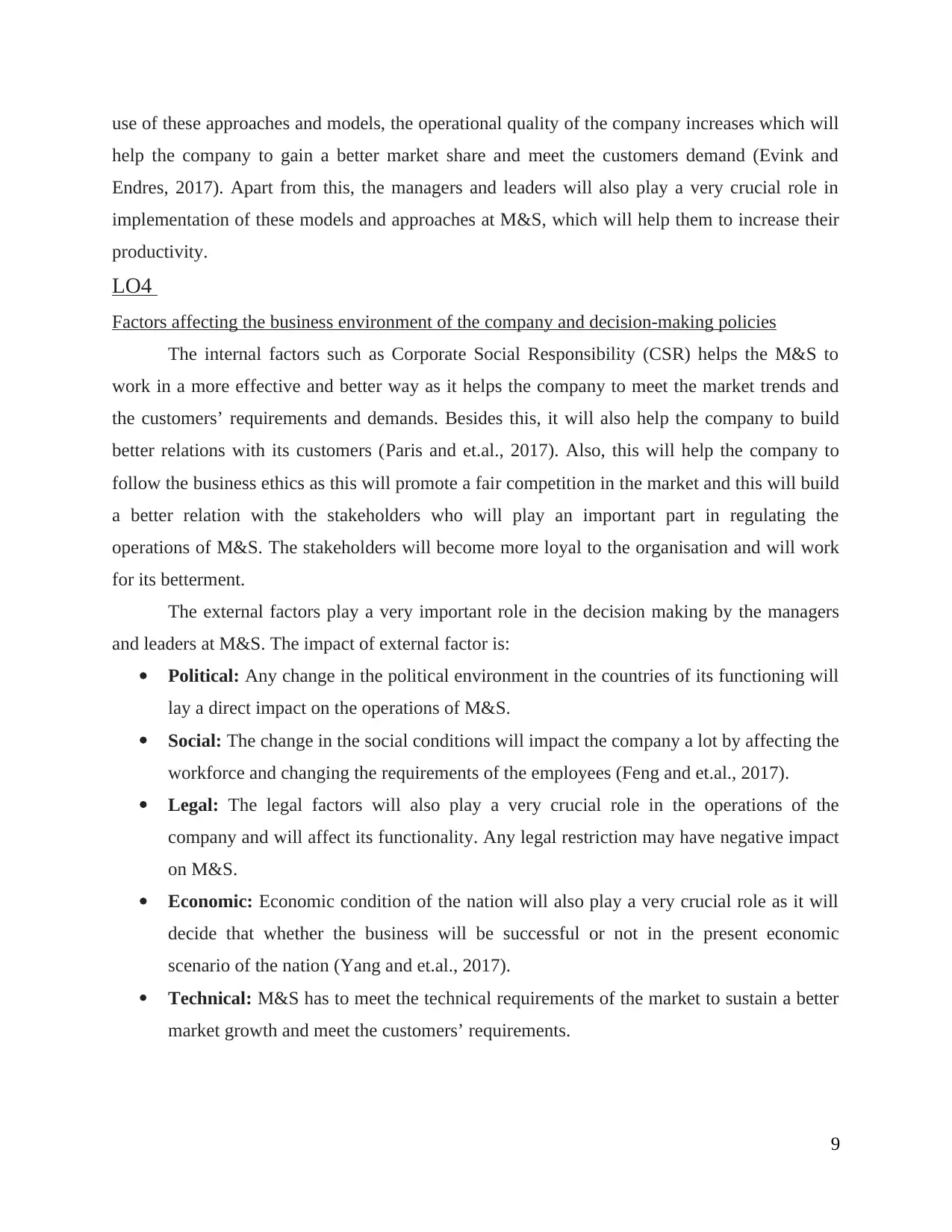
use of these approaches and models, the operational quality of the company increases which will
help the company to gain a better market share and meet the customers demand (Evink and
Endres, 2017). Apart from this, the managers and leaders will also play a very crucial role in
implementation of these models and approaches at M&S, which will help them to increase their
productivity.
LO4
Factors affecting the business environment of the company and decision-making policies
The internal factors such as Corporate Social Responsibility (CSR) helps the M&S to
work in a more effective and better way as it helps the company to meet the market trends and
the customers’ requirements and demands. Besides this, it will also help the company to build
better relations with its customers (Paris and et.al., 2017). Also, this will help the company to
follow the business ethics as this will promote a fair competition in the market and this will build
a better relation with the stakeholders who will play an important part in regulating the
operations of M&S. The stakeholders will become more loyal to the organisation and will work
for its betterment.
The external factors play a very important role in the decision making by the managers
and leaders at M&S. The impact of external factor is:
Political: Any change in the political environment in the countries of its functioning will
lay a direct impact on the operations of M&S.
Social: The change in the social conditions will impact the company a lot by affecting the
workforce and changing the requirements of the employees (Feng and et.al., 2017).
Legal: The legal factors will also play a very crucial role in the operations of the
company and will affect its functionality. Any legal restriction may have negative impact
on M&S.
Economic: Economic condition of the nation will also play a very crucial role as it will
decide that whether the business will be successful or not in the present economic
scenario of the nation (Yang and et.al., 2017).
Technical: M&S has to meet the technical requirements of the market to sustain a better
market growth and meet the customers’ requirements.
9
help the company to gain a better market share and meet the customers demand (Evink and
Endres, 2017). Apart from this, the managers and leaders will also play a very crucial role in
implementation of these models and approaches at M&S, which will help them to increase their
productivity.
LO4
Factors affecting the business environment of the company and decision-making policies
The internal factors such as Corporate Social Responsibility (CSR) helps the M&S to
work in a more effective and better way as it helps the company to meet the market trends and
the customers’ requirements and demands. Besides this, it will also help the company to build
better relations with its customers (Paris and et.al., 2017). Also, this will help the company to
follow the business ethics as this will promote a fair competition in the market and this will build
a better relation with the stakeholders who will play an important part in regulating the
operations of M&S. The stakeholders will become more loyal to the organisation and will work
for its betterment.
The external factors play a very important role in the decision making by the managers
and leaders at M&S. The impact of external factor is:
Political: Any change in the political environment in the countries of its functioning will
lay a direct impact on the operations of M&S.
Social: The change in the social conditions will impact the company a lot by affecting the
workforce and changing the requirements of the employees (Feng and et.al., 2017).
Legal: The legal factors will also play a very crucial role in the operations of the
company and will affect its functionality. Any legal restriction may have negative impact
on M&S.
Economic: Economic condition of the nation will also play a very crucial role as it will
decide that whether the business will be successful or not in the present economic
scenario of the nation (Yang and et.al., 2017).
Technical: M&S has to meet the technical requirements of the market to sustain a better
market growth and meet the customers’ requirements.
9
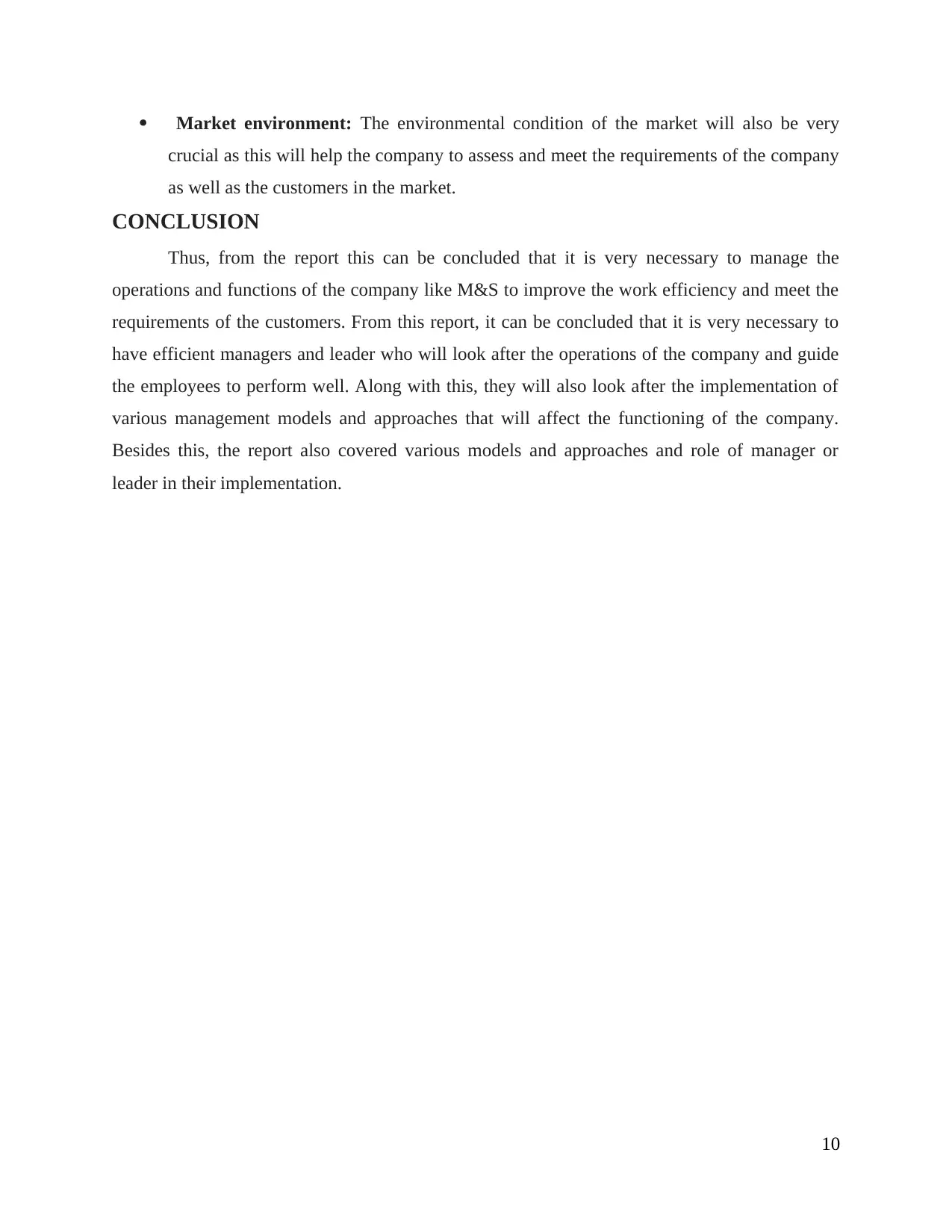
Market environment: The environmental condition of the market will also be very
crucial as this will help the company to assess and meet the requirements of the company
as well as the customers in the market.
CONCLUSION
Thus, from the report this can be concluded that it is very necessary to manage the
operations and functions of the company like M&S to improve the work efficiency and meet the
requirements of the customers. From this report, it can be concluded that it is very necessary to
have efficient managers and leader who will look after the operations of the company and guide
the employees to perform well. Along with this, they will also look after the implementation of
various management models and approaches that will affect the functioning of the company.
Besides this, the report also covered various models and approaches and role of manager or
leader in their implementation.
10
crucial as this will help the company to assess and meet the requirements of the company
as well as the customers in the market.
CONCLUSION
Thus, from the report this can be concluded that it is very necessary to manage the
operations and functions of the company like M&S to improve the work efficiency and meet the
requirements of the customers. From this report, it can be concluded that it is very necessary to
have efficient managers and leader who will look after the operations of the company and guide
the employees to perform well. Along with this, they will also look after the implementation of
various management models and approaches that will affect the functioning of the company.
Besides this, the report also covered various models and approaches and role of manager or
leader in their implementation.
10
⊘ This is a preview!⊘
Do you want full access?
Subscribe today to unlock all pages.

Trusted by 1+ million students worldwide
1 out of 14
Related Documents
Your All-in-One AI-Powered Toolkit for Academic Success.
+13062052269
info@desklib.com
Available 24*7 on WhatsApp / Email
![[object Object]](/_next/static/media/star-bottom.7253800d.svg)
Unlock your academic potential
Copyright © 2020–2025 A2Z Services. All Rights Reserved. Developed and managed by ZUCOL.





